check engine AUDI A6 2017 Owner's Manual
[x] Cancel search | Manufacturer: AUDI, Model Year: 2017, Model line: A6, Model: AUDI A6 2017Pages: 280, PDF Size: 70.24 MB
Page 205 of 280
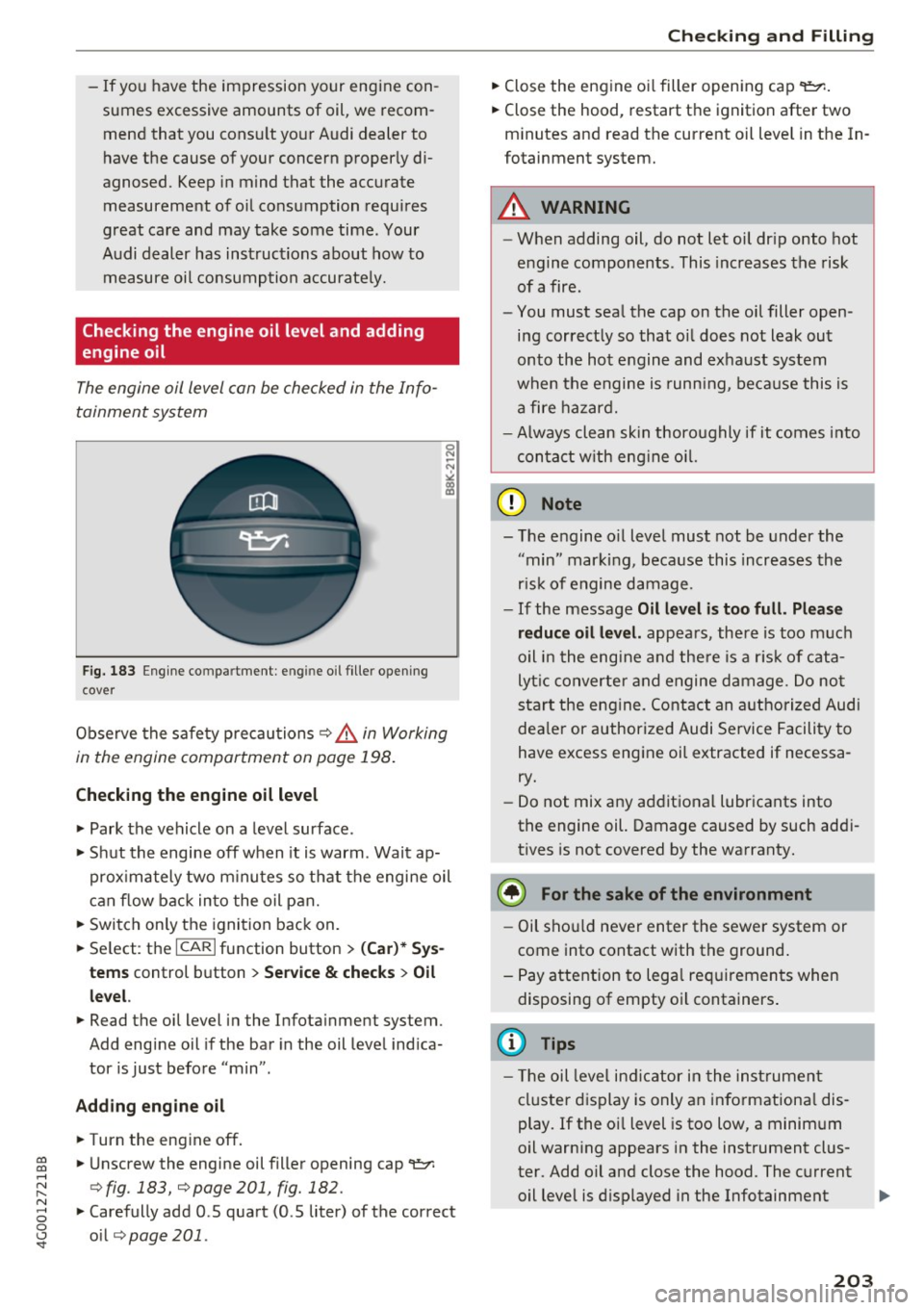
co
co
.... N
" N .... 0 0 <..:l '
sumes excessive amounts of oil, we recom
mend that you cons ult your Audi dealer to
have the cause of your concern properly di
agnosed. Keep in mind that the accurate
measurement of oil consumption requires
great care and may take some time. Your
A udi dealer has instructions about how to
measure oil consumption accurate ly.
Checking the engine oil level and adding
engine oil
The engine oil level can be checked in the Info
tainment system
Fig. 183 Eng ine compartment : eng ine oil filler opening
cover
Obse rve the safety precautions¢ &. in Working
in the engine compartment on page 198 .
Checking the engine oil level
.,. Park the vehicle on a level surface.
.,. Shut the engine off when it is warm. Wait ap
prox imately two m inutes so that the engine oil
can flow back in to the oil pan .
.,. Switch only the ignition back on.
.,. Se lect: the
ICARI function button > (Car )* Sy s
tems
control button > Service & checks > Oil
le vel.
.,. Read the oil level in the Infota inment system.
Add engine oil if the bar in the oil level indica
tor is just before "min".
Adding engine o il
.,. Turn the engine off.
.,. Unscrew the engine oil filler opening cap
"t!:r.
¢fig.183, ¢page 201, fig.182.
.,. Carefully add 0.5 quart (0.5 liter) of the correct
o il
¢ page 201.
Check ing and Filling
.,. Close the engine oi l filler open ing cap "t!:r. .
.,. Close the hood, restart the ignition after two
m inutes and read the current o il leve l in the In
fotainment system.
A WARNING
-When adding oil, do not let oi l dr ip onto hot
e ngine components. This increases the risk
of afire.
- You must seal the cap on the oil filler open
ing correctly so that oi l does not leak ou t
onto the hot engine and exhaust system
when the engine is runn ing, be ca use this is
a fire hazard.
- Always clean sk in thoro ughly if it comes into
con ta ct w ith eng ine oi l.
d) Note
-The e ngine o il level must not be under the
"min" marking, beca use this increases the
r is k of engine damage.
- If the message
Oil level is too full. Pleas e
reduce
oil level. appea rs, the re is too m uch
oil in the engine and the re is a r is k of cata
lyt ic converte r and engine damage. Do no t
start the eng ine. Co ntact an a uthorized Audi
dea ler or authorized Audi Service Facility to
have excess engine oil extracted if necessa
ry.
-Do not mix any ad ditiona l lubricants into
the engine oil. Damage caused by such add i
tives is not covered by the warranty .
@ For the sake of the environment
- Oil sho uld never enter the sewer system or
come into contact with the ground .
- Pay attention to lega l req uiremen ts when
disposing of empty oil containers .
(D Tips
- T he oil level in dicator in the inst rumen t
cl uster display is only an informationa l dis
play. If the o il level is too low, a minim um
oil warn ing appears in the instrument clus
ter. Add oil and close the hood. The c urrent
oil level is d isplayed in the Infotainment
203
Page 206 of 280
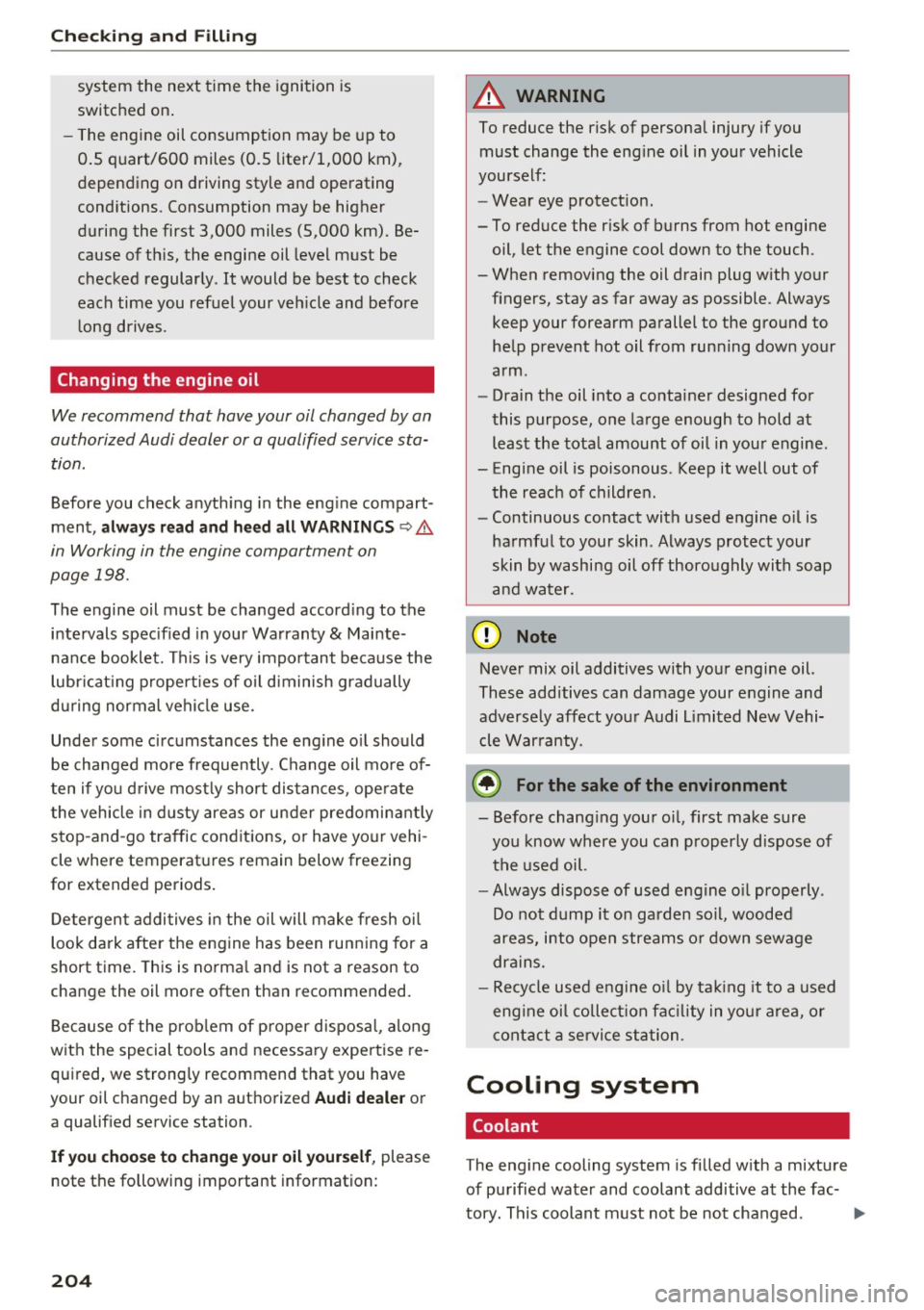
Checking and Filling
system the next time the ignition is
switched on.
- The engine oil consumption may be up to
0.5 quart/600 miles (0.5 liter/1 ,000 km),
depending on driving style and operating
conditions . Consumption may be higher
during the first 3,000 miles (5,000 km). Be
cause of this, the engine oil level must be
checked regularly .
It would be best to check
each time you refuel your vehicle and before
long drives .
Changing the engine oil
We recommend that have your oil changed by an
authorized Audi dealer or a qualified service sta
tion.
Before you check anything in the engine compart
ment ,
always read and heed all WARNINGS q .&.
in Working in the engine compartment on
page 198.
The engine oil must be changed according to the
intervals specified in your Warranty
& Mainte
nance booklet. This is very important because the
lubricating properties of oil diminish gradually
during normal vehicle use.
Under some circumstances the engine oil should
be changed more frequently . Change oil more of
ten if you drive mostly short distances , operate
the vehicle in dusty areas or under predominantly
stop-and-go traffic conditions, or have your vehi
cle where temperatures remain below freezing
for extended periods.
Detergent additives in the oil will make fresh oil
look dark after the engine has been running for a
short time. This is normal and is not a reason to
chang e the oil more often than recommended.
Because of the problem of proper disposal, along
with the special tools and necessary expertise re
quired, we strongly recommend that you have
your oil changed by an authorized
Audi dealer or
a qualified service station .
If you choose to change your oil yourself, please
note the following important information:
204
A WARNING
-
To reduce the risk of personal injury if you
must change the engine oil in your vehicle
yourself:
- Wear eye protection.
- To reduce the risk of burns from hot engine
-
oil, let the engine cool down to the touch .
- When removing the oil drain plug with your
fingers, stay as far away as possible. Always keep your forearm parallel to the ground to
help prevent hot oil from running down your
arm .
- Drain the oil into a container designed for
this purpose, one large enough to hold at
least the total amount of oil in your engine.
- Engine oil is poisonous . Keep it well out of
the reach of children.
- Continuous contact with used engine oil is
harmful to your skin . Always protect your
skin by washing oil off thoroughly with soap
and water.
(D Note
Never mix oil additives with your engine oil.
These additives can damage your engine and
adversely affect your Audi Limited New Vehi
cle Warranty.
@ For the sake of the environment
- Before changing your oil, first make sure you know where you can properly dispose of
the used oil.
- Always dispose of used engine oil properly .
Do not dump it on garden soil, wooded
areas, into open streams or down sewage
drains.
- Recycle used engine oil by taking it to a used
engine oil collection facility in your area, or
contact a service station .
Cooling system
Coolant
The engine cooling system is filled with a mixture
of purified water and coolant additive at the fac-
tory. This coolant must not be not changed. ..,.
Page 207 of 280
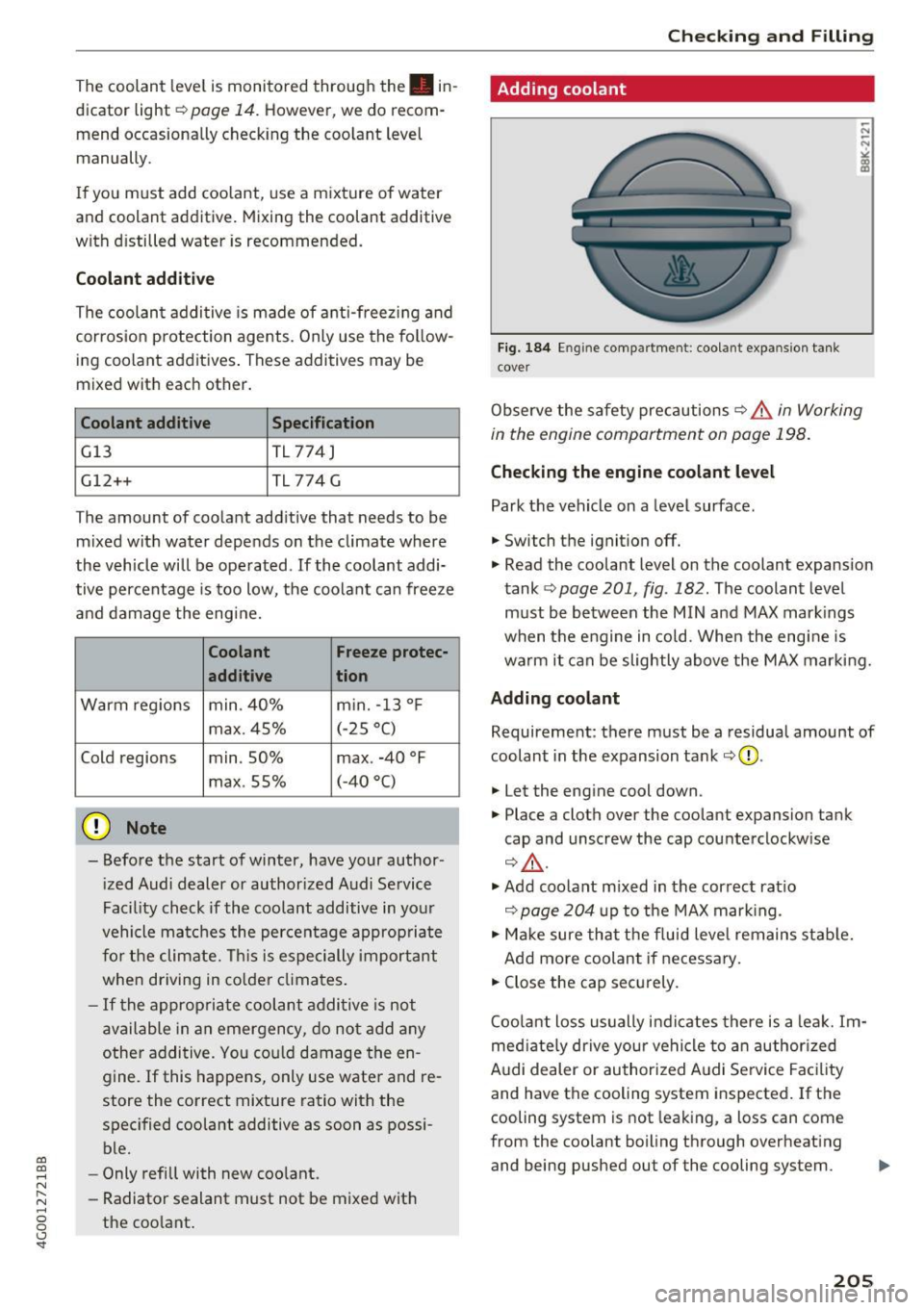
co
co
.... N
" N .... 0 0 <..:l 'SI'
The coolant leve l is monitored through the. in
dicator light
c::> poge 14. However, we do recom
mend occasionally check ing the coo lant level
manually.
If you m ust add coolant, use a m ixture o f water
and coolant additive . M ixing the coolant additive
w ith d istilled water is recommended.
Coolant additive
The coolan t addi tive is made of ant i-freez ing and
corrosion protection agents. Only use the fo llow
i n g coo lant additives . These additives may be
mixed wit h each other .
Coolant additive Specification
Gl3 TL774J
Gl2++ TL 774 G
The amount of coo lant add itive that needs to be
mixed with water depends on the climate where
the veh icle will be ope rated. If the coolant addi
tive percentage is too low, the cool ant can freeze
and damage the engine.
Coolant Freeze protec-
additive tion
Warm regions min . 40% m
in. -13 ° F
max. 45% (-25 °C)
Cold regions min . 50% max . -40 °F
max . 55% (-40 °C)
(D Note
-
Befo re the start of winter, have your author
i zed Audi dealer or author ized Audi Se rvice
Facility check if the coolant additive in yo ur
vehicle ma tches the percen tage approp riate
fo r th e climate. This is especially import ant
whe n driving in co lder climates .
-If the approp ria te coolant addi tive is no t
available in an emergency, do no t ad d any
other additive. You co uld damage the en
gine. If this happens, only use wate r and re
store the correct mixture ratio with the
spec ified coolant additive as soon as possi
ble.
- Only refill with new coo lant .
- Radiator sealant must not be mixed with
the coo lant .
Checking and Filling
Adding coolant
Fig. 184 En g in e compa rtment : coo lant expa nsion ta nk
cove r
Observe the safety prec autions c::> A in Working
in the engine comportmen t on page 198.
Checking the engine coolant level
Park the vehicle on a level surface.
.,. Switch t he ignit ion off.
.,. Read the coolant level on the coolant expansion
tank
c::> page 201, fig . 182. The coolant level
must be between the MIN and MAX mark ings
when the engine in cold. When the eng ine is
warm it can be slightly above the MAX marki ng.
Adding coolant
Requirement: there must be a residua l amount of
coolant in the expansion tank
c::> (D .
.,. Let the eng ine cool down .
.,. Place a cloth over the coolant expansion tank
cap and unscrew the cap counterclockw ise
c::> .&_ .
.,. Add coo lant m ixed in the cor rect rat io
c::> page 204 u p to the MAX mark ing.
.,. Ma ke sure that the f luid level remains stab le.
Add mo re coolant if necessary.
.,. Close the cap sec urely.
Coo la nt loss usually i ndicates there is a lea k. Im
med iate ly drive you r ve hicle to a n author ized
Audi dealer or authorized A udi Se rvice Faci lity
and have the cooling system inspected. If the
cooling system is not leak ing, a loss can come
from the coolant boiling through overheat ing
and being pushed out of the cooling system.
205
Page 208 of 280
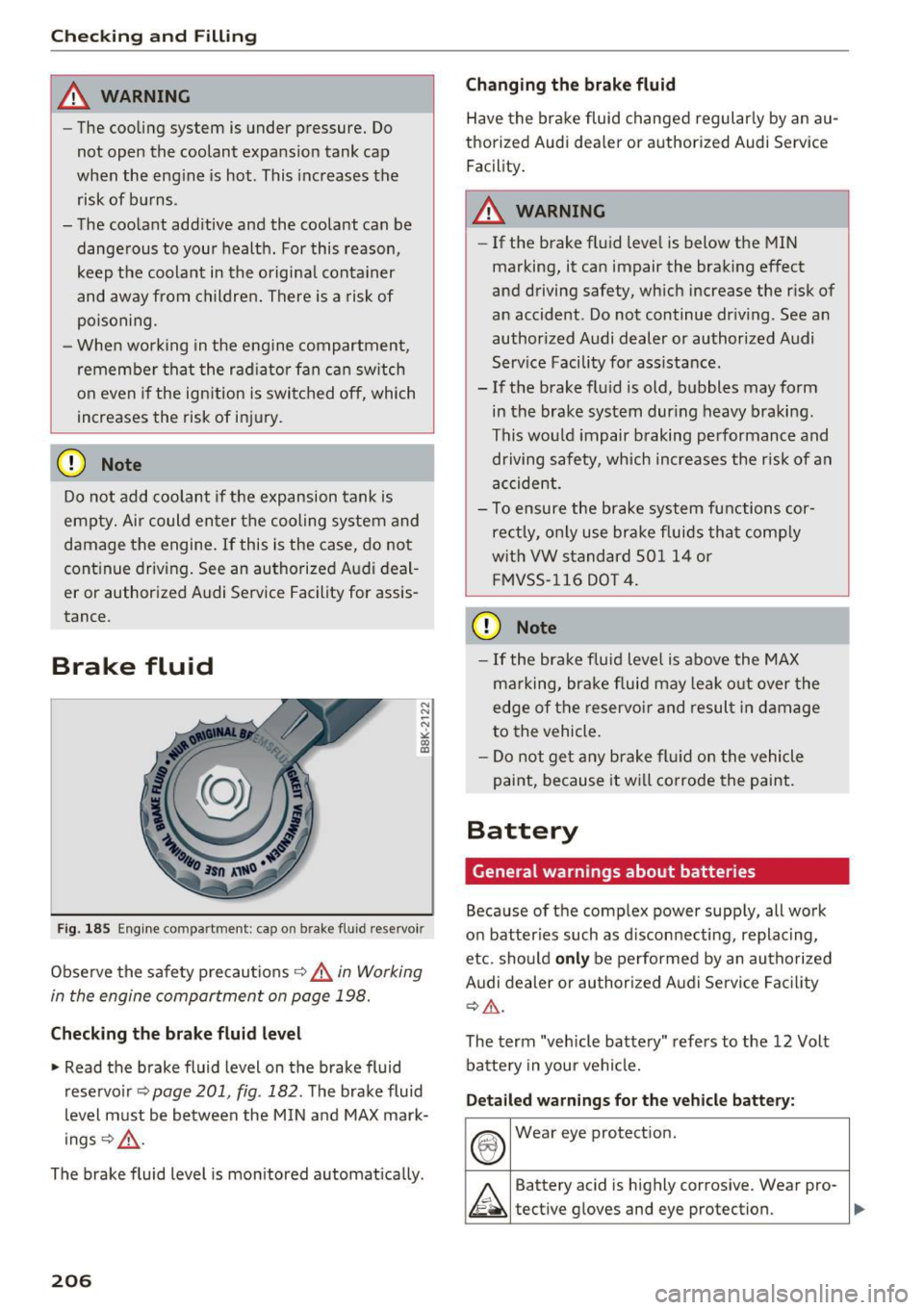
Checking and Filling
_& WARNING
-The cooling system is under pressure. Do
not open the coolant expansion tank cap
when the engine is hot. This increases the
risk of burns.
- The coolant additive and the coolant can be
dangerous to your health. For this reason,
keep the coolant in the original container
and away from children. There is a risk of
poisoning .
- When working in the engine compartment,
remember that the radiator fan can switch
on even if the ignition is switched off, which
increases the risk of injury.
CD Note
Do not add coolant if the expansion tank is
empty. Air could enter the cooling system and
damage the engine. If this is the case, do not
continue driving. See an authorized Audi deal
er or authorized Audi Service Facility for assis
tance .
Brake fluid
Fig. 185 Engine compartment : ca p on brake fl uid re servoir
Observe the safety precautions c::> .&. in Working
in the engine comportment on page 198.
Checking the brake fluid level
• Read the brake fluid level on the brake fluid
reservoir
c::> page 201, fig . 182. The brake fluid
level must be between the MIN and MAX mark
i n gs c::> .,&. .
The brake fluid level is monitored automatically .
206
Changing the brake fluid
Have the brake fluid changed regularly by an au
thorized Audi dealer or authorized Audi Service Facility.
_& WARNING
- If the brake fluid level is below the MIN
marking, it can impair the braking effect
-
and driving safety, which increase the risk of
an accident . Do not continue driving . See an
authorized Audi dealer or authorized Audi
Service Facility for assistance.
- If the brake fluid is old, bubbles may form
in the brake system during heavy braking.
This would impair braking performance and driving safety, which increases the risk of an
accident .
- To ensure the brake system functions cor
rectly, only use brake fluids that comply
with VW standard 50114 or FMVSS-116 DOT 4.
CD Note
-If the brake fluid level is above the MAX
marking, brake fluid may leak out over the
edge of the reservoir and result in damage
to the vehicle.
- Do not get any brake fluid on the vehicle
paint, because it will corrode the paint.
Battery
General warnings about batteries
Because of the complex power supply, all work
on batteries such as disconnecting, replacing,
etc. should
only be performed by an authorized
Audi dealer or authorized Audi Service Facility
c:::, &.
The term "vehicle battery" refers to the 12 Volt
battery in your vehicle.
Detailed warnings for the vehicle battery:
®) Wear eye protection.
~ Battery acid is highly corrosive. Wear pro-
~ tect1ve gloves and eye protection. ..,.
Page 209 of 280
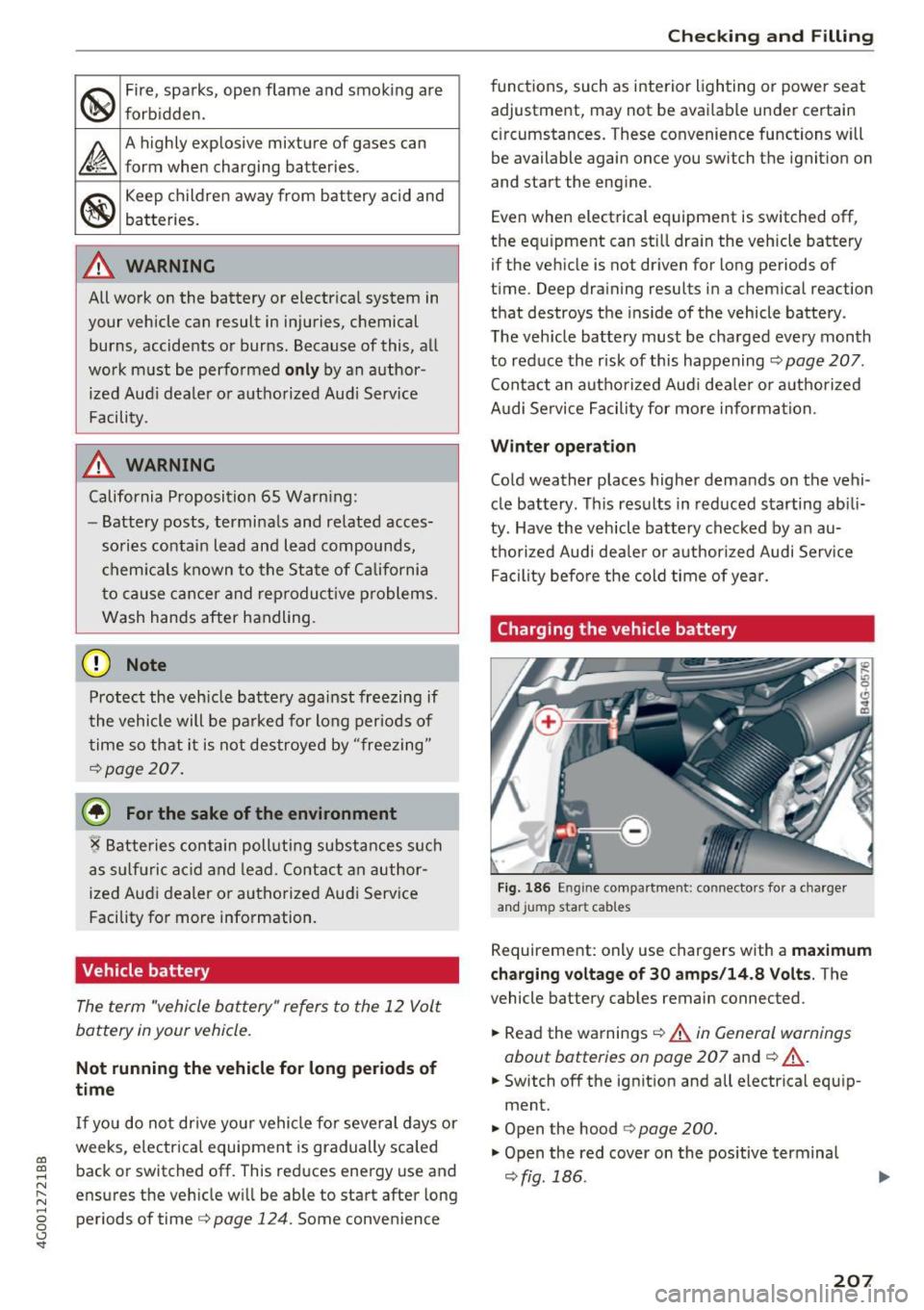
co
co
.... N
" N .... 0 0 <.,;) 'SI"
@
Fire, sparks, open flame and smoking are
forb idden.
~
A highly explosive mixture of gases can
form when charging batteries.
®
Keep children away from battery acid and
batteries.
A WARNING
All work on the battery or electrical system in
your vehicle can result in injuries, chemical
burns, accidents or burns. Because of this, all
work must be performed
only by an author
ized Aud i dealer or authorized Aud i Service
Facility.
A WARNING
California Proposition 65 Warning:
- Battery posts, terminals and related acces
sories contain lead and lead compounds,
chemicals known to the State of California
to cause cancer and reproduct ive problems.
Wash hands after handling.
(D Note
Protect the vehicle battery against freezing if
the vehicle will be parked for long periods of
time so that it is not destroyed by "freezing"
c:>page207.
@ For the sake of the environment
~ Batteries contain poll uting substances such
as sulfuric acid and lead. Contact an author
ized Audi dealer or authorized Audi Service
Facility for more information.
Vehicle battery
The term "vehicle battery" refers to the 12 Volt
battery in your vehicle.
Not running the vehicle for long periods of
time
If you do not drive your vehicle for several days or
weeks, e lectrical equipment is gradually scaled
back or switched off. This reduces energy use and
ensures the veh icle will be able to start after long
periods of time
c:> page 124. Some convenience
Checking and Filling
functions, such as interior lighting or power seat
adjustment, may not be available under certa in
c ir cumstances. These convenience functions will
be available again once you switch the ignition on
and start the engine .
Even when electrical equipment is switched off,
the equipment can still dra in the vehicle battery
if the vehicle is not driven for long periods of
time . Deep draining results in a chemical reaction
that destroys the inside of the vehicle battery .
T he veh icle battery must be charged every month
to reduce the risk of this happening
c:> page 207 .
Contact an authorized Aud i dea ler or authorized
A udi Service Facility for more information .
Winter operation
Cold weather places higher demands on the vehi
cle battery . This results in reduced starting abili
ty. Have the veh icle battery checked by an au
thorized Audi dea ler or authorized Audi Service
Facility before the cold time of year.
Charging the vehicle battery
Fig. 186 En g in e compa rtment: co nnectors for a cha rge r
and ju mp start cables
Requirement: only use chargers with a maximum
charging voltage of 30 amps/14.8 Volts.
The
vehicle battery cables remain connected .
.,. Read the warnings
c:> &. in General warnings
about batteries on page 207
and ¢ &_ .
.,. Switch off the ignit ion and all electrical equ ip
ment.
.,. Open the hood
c:> page 200.
"'Open the red cover on the pos itive terminal
c:> fig. 186 .
207
Page 211 of 280
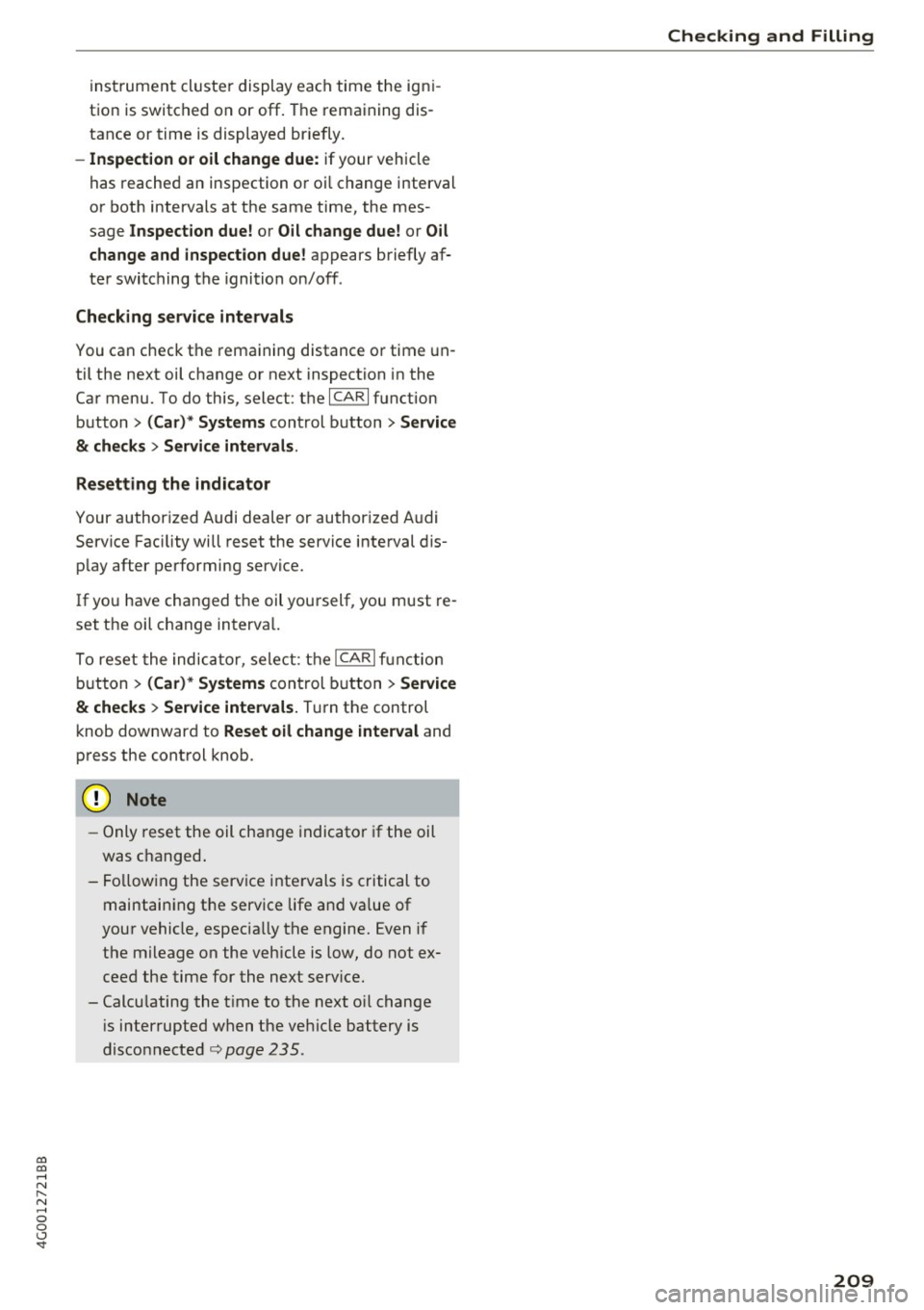
co
co
.... N
" N .... 0 0 <..:l '
t io n is switc hed on or
off . The rema ining dis
tance or time is displayed br ie fly .
- Inspection or oil change due: if your vehicle
has reac hed an inspection o r oi l change interval
o r both intervals at the same time, the mes
sage
Inspection due! or Oil change due! or Oil
change and inspection due!
appears briefly af
te r swi tching t he igni tion on/off .
Checking service intervals
You can check t he rema ining distance o r time un
til the ne xt oil change o r next inspection i n the
Ca r menu. To do this, select: t he
IC A RI fu nction
b utton
> (Car) * Systems cont rol b utton > Service
& checks > Service intervals.
Resetting the indicator
Your author ized Audi dealer or author ized A udi
Service Faci lity will reset the service interval dis
p lay after pe rforming service.
I f yo u h ave cha nged t he oi l you rsel f, you must re
set t he oil change in terva l.
To reset the indic ator, se le ct : th e
ICAR I fu nct ion
bu tton
> (Car) * Systems con trol button > Service
& checks > Service intervals. Tur n t he control
k nob downward to
Reset oil change interval and
p ress the cont rol knob.
- Only reset the oil ch ange in dicato r if the oil
was c hanged .
- Fo llow in g th e service i nte rv a ls is critical to
mai ntai ning th e service life a nd value o f
you r vehicle, especia lly t he engine. Even i f
t h e m ileage on the vehicle is low, do not ex
c e ed th e tim e for the n ext serv ic e .
- Calcu latin g the t ime to the next o il chan ge
i s interrupted w hen the ve hicle battery is
discon nect ed
c:> page 235.
Checking and Filling
209
Page 239 of 280
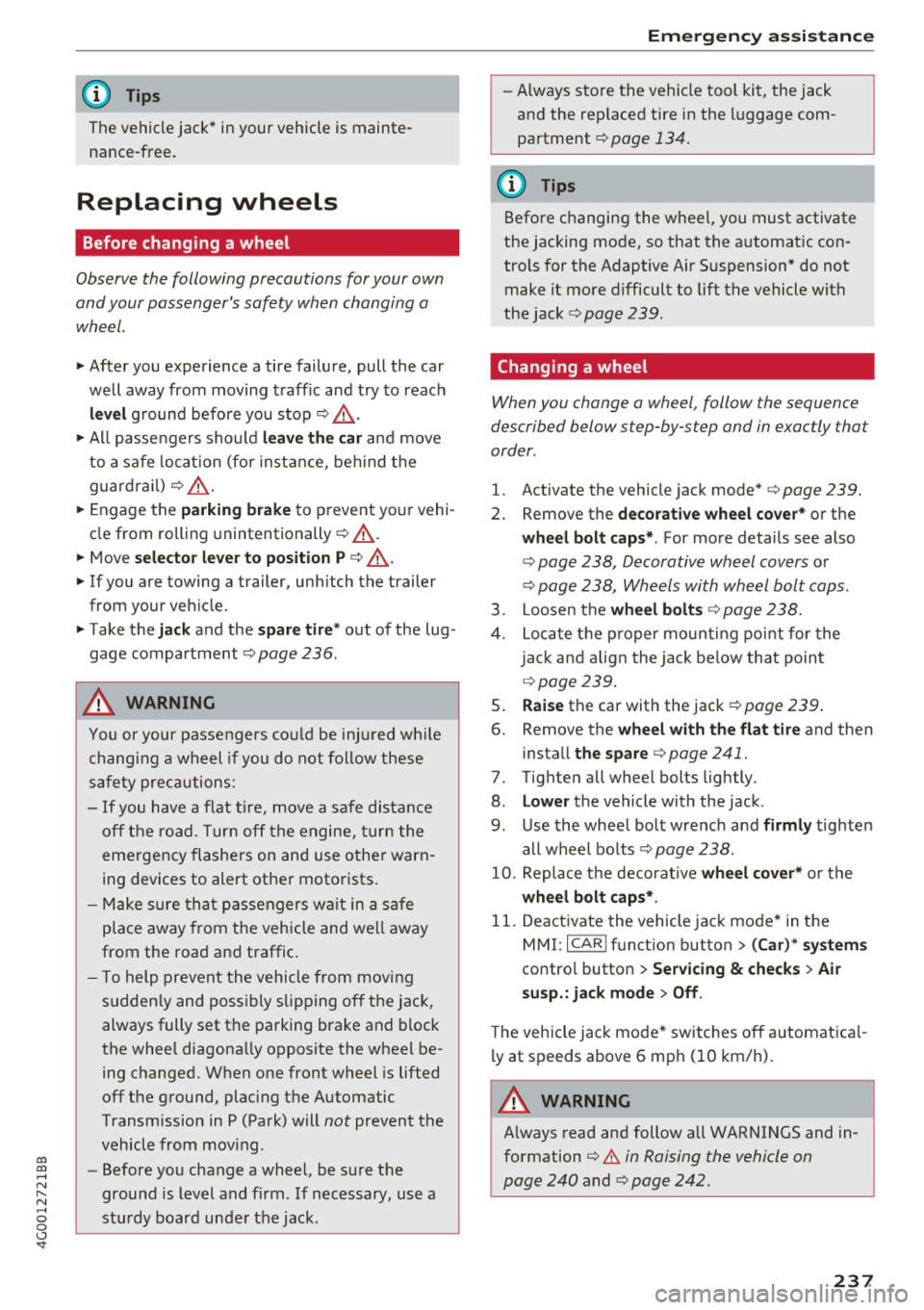
co
co
.... N
" N .... 0 0 <..:l '
The vehicle jack* in your vehicle is mainte
nance-free.
Replacing wheels
Before changing a wheel
Observe the following precautions for your own
and your passenger's safety when changing a
wheel .
.,. After you experience a tire failure, pull the car
well away from moving traffic and try to reach
level ground before you stop¢,&. .
.,. All passengers should
leave the car and move
to a safe location (for instance, beh ind the
guardrail)¢ ,&..
.. Engage the
parking brake to prevent your vehi
cle from rolling unintentionally ¢,&. .
.. Move
selector lever to position P ¢ ,&. .
.,. If you are towing a trailer, unhitch the trailer
from your vehicle.
.,. Take the
jack and the spare tire* out of the lug
gage compartment c:> page 236.
A WARNING
You or your passengers could be inju red wh ile
changing a wheel if you do not follow these
safety precautions:
- If you have a flat tire, move a safe distance
off the road. Turn off the engine, turn the
emergency flashers on and use other warn
ing devices to alert other motorists .
- Make sure that passengers wait in a safe
place away from the vehicle and well away
from the road and traffic.
- T o help prevent the vehicle from moving
sudden ly and possibly slipping off the jack,
always fully set the parking brake and block
the wheel diagonally opposite the wheel be ing changed. When one front wheel is lifted
off the ground, plac ing the Automatic
Transmission in P (Park) will
not prevent the
vehicle from mov ing.
- Before you change a wheel, be sure the
ground is level and firm. If necessary, use a
sturdy board under the jack .
Emergency assistance
-Always store the vehicle too l kit, the jack
and the replaced tire in the luggage com
partment
¢page 134.
@ Tips
Before changing the wheel, you must activate
the jacking mode, so that the automatic con
tro ls for the Adaptive Air Suspension* do not
make it more difficult to lift the vehicle with
the jack
c> page 239.
Changing a wheel
When you change a wheel, follow the sequence
described below step-by-step and in exactly that
order .
l. Activate the vehicle jack mode* ¢ page 239 .
2. Remove the decorative wheel cover* or the
wheel bolt caps* . For more details see also
¢ page 238, Decorative wheel covers or
¢ page 238, Wheels with wheel bolt caps .
3. Loosen the wheel bolts¢ page 238 .
4. Locate the proper mounting point for the
jack and align the jack below that point
¢page 239.
5. Raise the car with the jack c> page 239 .
6. Remove the wheel with the flat tire and then
install
the spare ¢ page 241.
7. Tighten all wheel bolts lightly.
8.
Lower the vehicle with the jack .
9 . Use the wheel bolt wrench and
firmly tighten
all wheel bolts
c> page 238.
10. Replace the decorative wheel cover* or the
wheel bolt caps*.
11. Deactivate the vehicle jack mode* in the
MMI:
I CARI function button > ( Car)* systems
control button > Servicing & checks > Air
susp.: jack mode > Off.
The vehicle jack mode* switches off automatica l
ly at speeds above 6 mph (10 km/h).
A WARNING
--
Always read and follow all WARNINGS and in
formation
¢ .&. in Raising the vehicle on
page 240
and c> page 242 .
237
Page 251 of 280
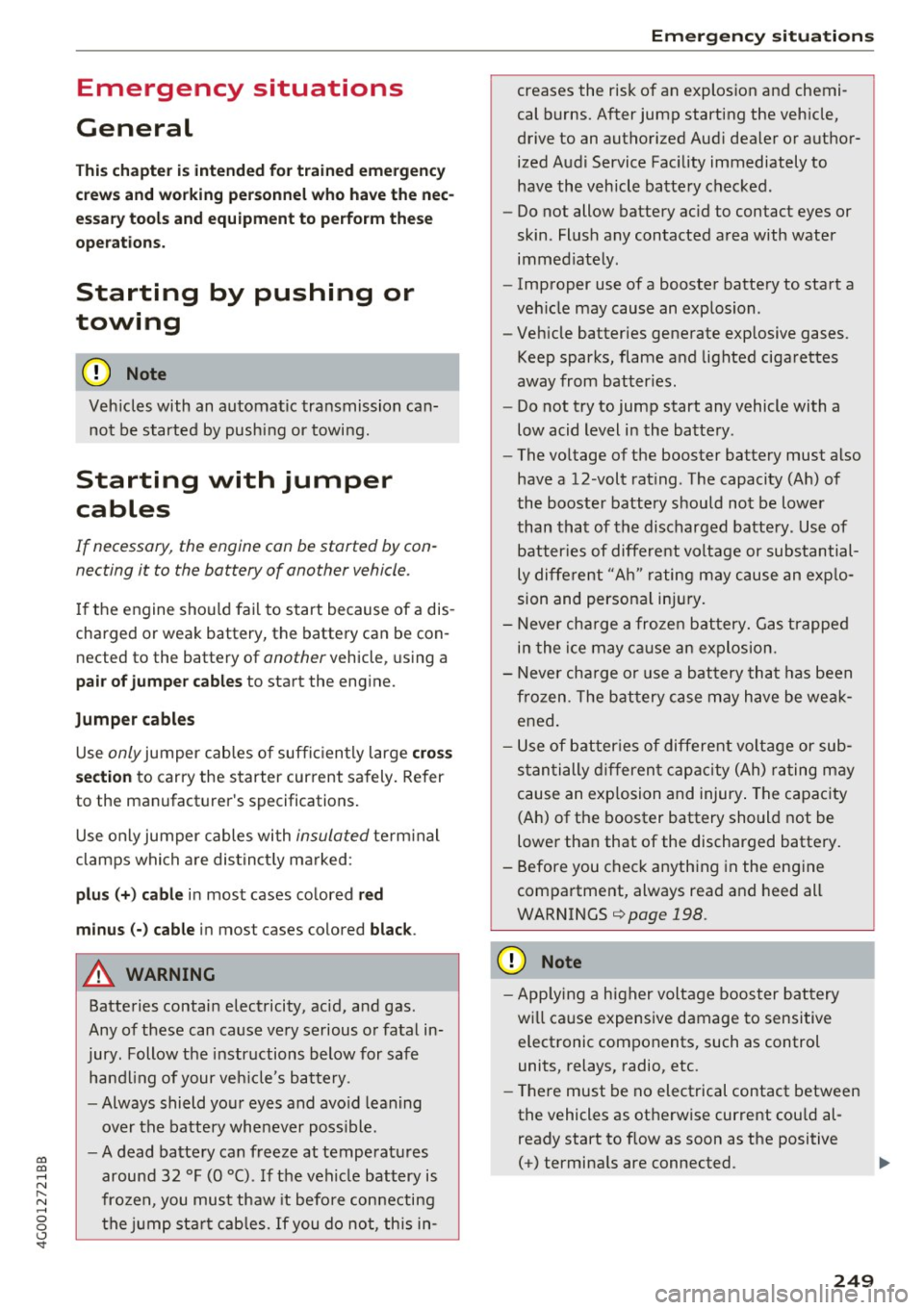
co
co
.... N
" N .... 0 0 <..:l '
General
This chapter is intended for trained emergency
crews and working personnel who have the nec
essary tools and equipment to perform these
ope rations.
Starting by pushing or
towing
CD Note
Veh icles with an automatic transmission can
not be started by pushing or towing.
Starting with jumper
cables
If necessary, the engine can be started by con
necting it to the battery of another vehicle.
If the engine shou ld fail to start because of a dis
charged or weak battery, the battery can be con
nected to the battery of
another vehicle, using a
pair of jumpe r cables to start the engine.
Jumper cables
Use only jumper cables of suffic iently large cross
section
to carry the starter current safely. Refer
to the manufacturer's specifications.
Use only jumper cables with
insulated term inal
clamps which are dis tinct ly marked:
plus (+) cable in most cases colored re d
minus( -) cable
in most cases colored black.
A WARNING
Batteries contain electricity, acid, and gas.
Any of these can cause very serious or fatal in
jury. Follow the instructions below for safe
handling of your vehicle's battery.
- Always shield your eyes and avo id leaning
over the battery whenever poss ible.
- A dead battery can freeze at temperatures
around 32 °F (0 °C). If the vehicle battery is
frozen, you must thaw it before connecting
the jump start cab les. If you do not, this in-
Emergency situations
creases the risk of an explosion and chemi
cal burns. After jump starting the vehicle,
drive to an authorized Aud i dealer or author
ized Audi Service Facility immediately to
have the vehicle battery checked.
- Do not allow battery ac id to contact eyes or
skin . Flush any contacted area with water
immed iately.
- Improper use of a booster battery to start a
veh icle may cause an explosion .
- Veh icle batteries generate explosive gases.
Keep sparks, flame and lighted cigarettes
away from batter ies.
- Do not try to jump start any vehicle with a
low acid level in the battery .
- The voltage of the booster battery must also
have a 12-volt rat ing . The capacity (Ah) of
the booster battery should not be lower
than that of the discharged battery. Use of
batter ies of different voltage or substantial
ly different "Ah" rating may cause an exp lo
sion and personal injury.
- Never charge a frozen battery. Gas trapped
in the ice may cause an explosion.
- Never charge or use a battery that has been
frozen . T he battery case may have be weak
ened.
- Use of batteries of different voltage or sub
stantially different capacity (Ah) rating may
cause an exp losion and injury . The capacity
(Ah) of the booster battery should not be
lower than that of the discharged battery.
- Before you check anything in the engine
compartment, always read and heed all
WARNINGS
qpage 198.
CD Note
-App lying a higher voltage booster battery
wi ll ca use expensive damage to sensitive
electronic components, such as control
units, relays, radio, etc.
- There must be no electrical contact between
the vehicles as otherwise current could al
ready start to flow as soon as the positive
(+) terminals are connected.
249
Page 253 of 280
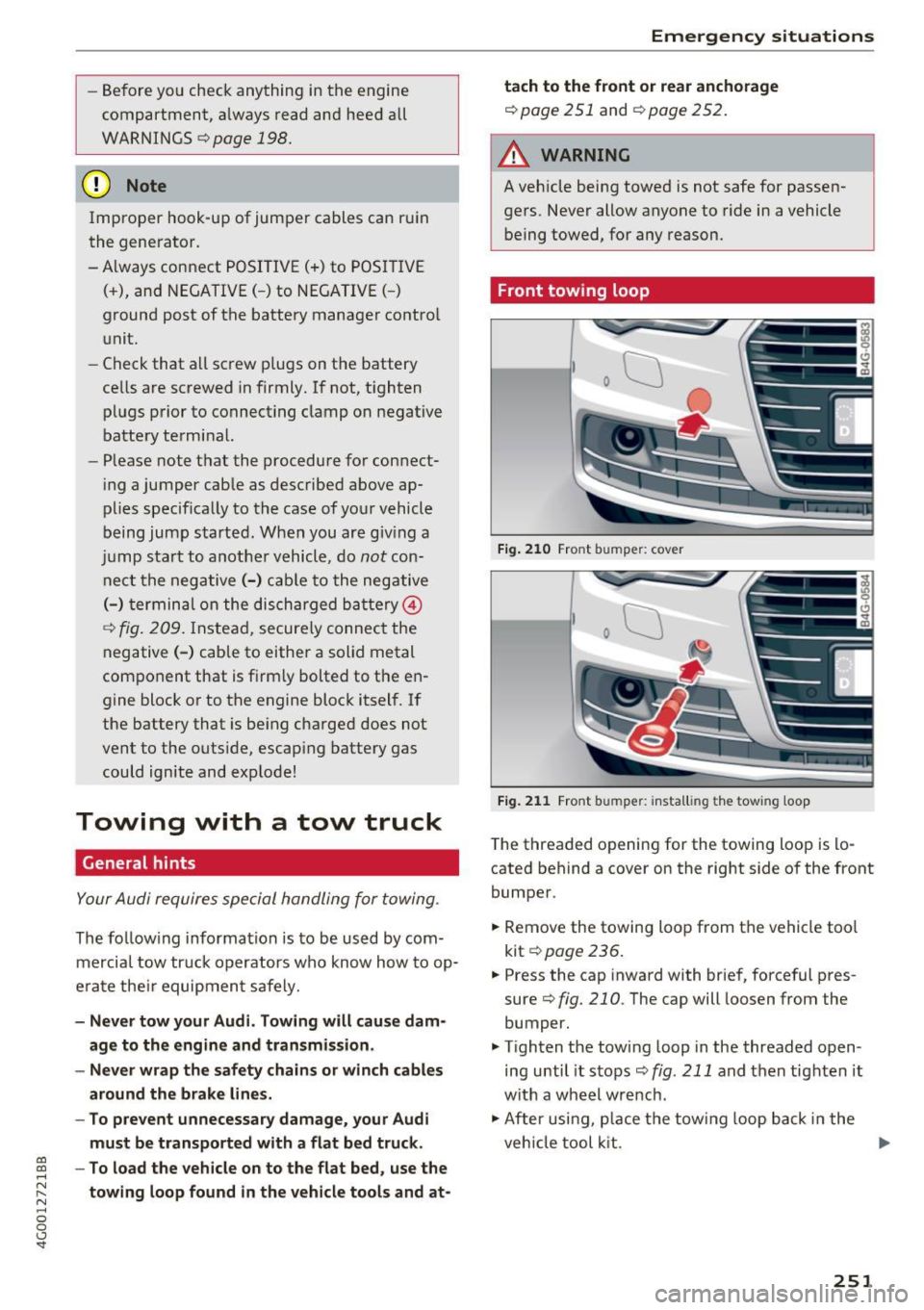
-Before you check anything in the engine
compartment, always read and heed all
WARNINGS
o page 198.
(D Note
Improper hook-up of jumper cables can ruin
the generator.
-Always connect POSITIVE( +) to POSITIVE
(+), and NEGATIVE(-) to NEGATIVE(-)
ground post of the battery manager control
unit.
- Check that all screw plugs on the battery
cells are screwed in firmly. If not, t ighten
plugs prior to connecting clamp on negative
battery terminal.
- Please note that the procedure for connect
ing a jumper cable as described above ap
plies specifically to the case of your vehicle
being jump started. When you are giv ing a
ju mp start to another vehicle, do
not con
ne ct the negative( -) cab le to the negative
(-) terminal on the discharged ba ttery @
o fig. 209. Instead, securely connec t the
negative (-) cable to either a solid metal
component that is firm ly bolted to the en
gine block or to the engine block itself. If
the battery that is be ing charged does not
vent to the outs ide, escaping battery gas
could ignite and explode!
Towing with a tow truck
General hints
Your Audi requires special handling for towing .
The following information is to be used by com
mercial tow truck operators who know how to op
erate the ir equipment safely.
-Never tow your Audi. Towing will cause dam
age to the engine and transmission .
- Never wrap the safety chains or winch cables
around the brake lines.
- To prevent unnecessary damage, your Audi
must be transported with a flat bed truck .
co
co -To load the vehicle on to the flat bed, use the ....
~ towing loop found in the vehicle tools and at-N .... 0 0 <.,;) 'SI"
Emergency situations
tach to the front or rear anchorage
opage251 and opage252.
.&_ WARNING
-
A vehicle being towed is not safe for passen-
gers. Never allow anyone to ride in a vehicle
being towed, for any reason.
Front towing loop
Fig. 210 Front bumper: cover
Fig. 211 Front bu mper: insta lling t he towing loop
The threaded open ing for the towing loop is lo
cated behind a cover on the right side of the front
bumper .
.,. Remove the towing loop from the vehicle too l
kit
c:::, page 236.
.,. Press the cap inward with brief, forceful pres
sure
o fig. 210 . The cap will loosen from the
bumper.
., Tighten the towing loop in the threaded open
ing until it stops
r:';> fig. 211 and then tighten it
w ith a wheel wrench .
.,. After usi ng, p lace the towing loop back in the
veh icle tool kit . "'
251
Page 255 of 280

co
co
.... N
" N .... 0 0 <.,;) 'SI"
Raising the vehicle
Lifting with workshop hoist and with floor
jack
The vehicle may only b e li~ ed at the lifting
points illustra ted.
F ig. 215 Front lift ing po int
F ig. 216 Rea r lift ing po int
.,. Read and heed WARNING c:> &_ .
.. Activate the vehicle jack mode* in the MMI:
I CAR I funct ion button> (Car) * systems contro l
button >
Servicing & checks > Air susp.: jack
mode > On .
.. Loca te lift ing po ints c:> fig . 215 and c:> fig . 216 .
.. Adju st lifting arms of wo rkshop ho ist o r floo r
j ac k t o ma tch vehicl e lifting poin ts.
.. In se rt a rub ber pa d between the f loor jack/
wor kshop hoist a nd the lifting points .
T he vehicle ja ck mode* mus t be activa ted so th at
the au tomatic a djustment of the Adaptive Air
Suspension * does not make it more d ifficult to
raise the ve hicle w it h the floo r jack.
If you must lift your vehicle with a floor jack to
work underneath , be sure the vehicle is safely
supported on stands intended for this purpose .
Emergency situations
Front lifting point
The li fting poin t is lo cate d on the floor p an rein
f orceme nt ab out at the same level as the ja ck
mounting point
c:> fig . 215 . Do not lift the vehi
cle at the vertical sill reinforcement.
Rear lifting point
T he lifting point is lo cated on the ver tic al rein
f orcement o f the lower s ill for the on- bo ar d jac k
<=>fig. 216.
Lifting with vehicle jack
Refer to c:> pag e 239 .
A WARNING
- To reduce the r is k of se rious inju ry and vehi
cle damag e.
- Always lift the vehicle on ly at the special
workshop h oist a nd floor jack lift points
il
lustrated c:>fig. 215 and c:>fig. 216.
-Failure to lift t he veh icle at these points
could cause t he veh icle to tilt o r fall from
a lift i f th ere is a change in vehicle weight
dist ribution and balance . This might hap
pen, fo r example, when heavy compo
n en ts such as the eng ine block o r tran s
mis sio n a re re moved .
- Whe n re mov ing heavy co m ponents like
these, an ch or vehicle t o hois t or ad d co rre
spon ding weig hts t o m aintai n the cen ter of
g ravi ty . Ot herw ise, the vehicle mig ht tilt or
slip off t he hoist, caus ing se rious pe rsonal
i njur y .
(D Note
-Be aw are of the fo llow ing points b efor e lift
ing the vehicle:
-The vehicle should never be lifted or
jacked up from underneath the engine oil
pan, the transmission housing, the front
or rear axle or the body side members.
This could lead to serious damage .
- To avoid damage to the underbody or
chassis frame, a rubber pad must be in
serted between the floor jack and the lift
points . .,.
253